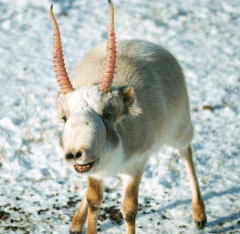 |
| Unique in its genus, the saiga antelope inhabits the steppes and semi-desert environments in two sub-species split between Kazakhstan (Saiga tatarica tatarica, ~ 80% of the individuals) and Mongolia (Saiga tatarica mongolica). Locals hunt them for their meat and the (attributed) medicinal properties of male horns. Like many ungulates, the population is sensitive to winter severity and summer drought (which signal seasonal migrations of herds up to 1000 individuals). But illegal poaching has reduced the species from > 1 million in the 1970s to ~ 50000 currently (see RT video). The species has gone extinct in China and Ukraine, and has been IUCN “Critically Endangered” from 2002. The photo shows a male in The Centre for Wild Animals, Kalmykia, Russia (courtesy of Pavel Sorokin). |
In a planet approaching 7 billion people, individual identity for most of us goes largely unnoticed by the rest. However, individuals are important because each can promote changes at different scales of social organisation, from families through to associations, suburbs and countries. This is not only true for the human species, but for any species (1).
It is less than two decades since many ecologists started pondering the ways of applying the understanding of how individuals behave to the conservation of species (2-9), which some now refer to as ‘conservation behaviour’ (10, 11). The nexus seems straightforward. The decisions a bear or a shrimp make daily to feed, mate, move or shelter (i.e., their behaviour) affect their fitness (survival + fertility). Therefore, the sum of those decisions across all individuals in a population or species matters to the core themes handled by conservation biology for ensuring long-term population viability (12), i.e., counteracting anthropogenic impacts, and (with the distinction introduced by Cawley, 13) reversing population decline and avoiding population extinction.
To use behaviour in conservation implies that we can modify the behaviour of individuals to their own benefit (and mostly, to the species’ benefit) or define behavioural metrics that can be used as indicators of population threats. A main research area dealing with behavioural modification is that of anti-predator training of captive individuals prior to re-introduction. Laden with nuances, those training programs have yielded contrasting results across species, and have only tested a few instances of ‘success’ after release into the wild (14). For example, captive black-tailed prairie dogs (Cynomys ludovicianus) exposed to stuffed hawks, caged ferrets and rattlesnakes had higher post-release survival than untrained individuals in the grasslands of the North American Great Plains (15). A clear example of a threat metric is aberrant behaviour triggered by hunting. Eleanor Milner-Gulland et al. (16) have reported a 46 % reduction in fertility rates in the saiga antelope (Saiga tatarica) in Russia from 1993-2002. This species forms harems consisting of one alpha male and 12 to 30 females. Local communities have long hunted this species, but illegal poaching for horned males from the early 1990s (17) ultimately led to harems with a female surplus (with an average sex ratio up to 100 females per male!). In them, only a few dominant females seem to reproduce because they engage in aggressive displays that dissuade other females from accessing the males. Read the rest of this entry »


